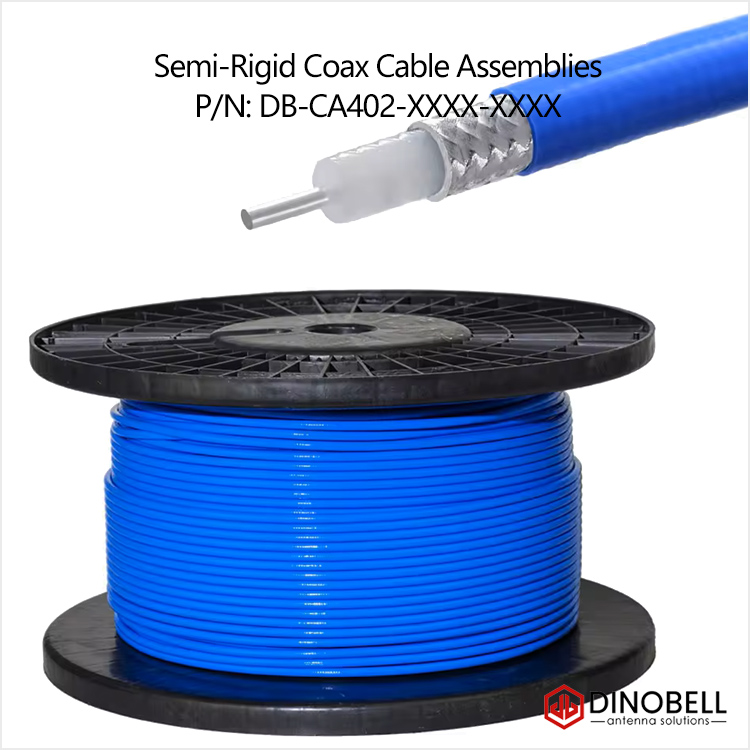Custom Semi-Rigid Cable Assemblies
With the long experience as semi-rigid cable manufacturer, Dinobell supports variety of customer needs from 1pc of minimum order. If you have your own requirements on cable selection, configuration, design and electrical properties, please contact us. Dinobell satisfies your demands from special combination of cable materials to optimal connector development integrating accumulated know-how into an assembly.
Part Number:
DB-SRC020-XXXX with cable sizes: .020″
DB-SRC047-XXXX with cable sizes: .047″
DB-SRC086-XXXX with cable sizes: .086″
DB-SRC141-XXXX with cable sizes: .141″
DB-SRC250-XXXX with cable sizes: .250″


Semi-rigid coaxial cable assemblies are available in various configurations, including straight, right-angle, and custom bends, to accommodate different installation requirements and space constraints. They are commonly used in high-frequency applications such as telecommunications, aerospace, defense, medical equipment, and test and measurement systems, where stable signal transmission and low loss are critical.
The Semi-Rigid cables are available with a copper jacket and available with a selection of different platings and 5 different diameters (.020″, .047″, .086″, .141″ & .250″) .
Some knowledge about Semi-rigid coaxial cable assemblies
Semi-rigid coaxial cable assemblies can be classified into several types based on factors such as their design, materials used, and specific applications. Here are some common types:
- Standard Semi-Rigid Coaxial Cable Assemblies: These assemblies feature standard semi-rigid coaxial cables with solid outer conductors and are used in a wide range of applications where stability and low signal loss are required.
- Phase-Matched Semi-Rigid Coaxial Cable Assemblies: In these assemblies, multiple semi-rigid cables are precisely manufactured to have matched electrical lengths, ensuring phase consistency between signals. They are commonly used in applications such as phased-array radar systems and antenna arrays.
- Armored Semi-Rigid Coaxial Cable Assemblies: Armored semi-rigid cables have an additional layer of protection, typically made of stainless steel or another rugged material, providing enhanced mechanical durability and resistance to environmental factors such as vibration, abrasion, and impact.
- High-Frequency Semi-Rigid Coaxial Cable Assemblies: Designed for applications requiring transmission of high-frequency signals, these assemblies feature cables optimized for low loss and high performance at frequencies ranging from several gigahertz to beyond 100 GHz.
- Custom Semi-Rigid Coaxial Cable Assemblies: Custom-designed assemblies tailored to specific customer requirements, which may include unique connector configurations, cable lengths, and special shielding or insulation materials.
- Temperature-Compensated Semi-Rigid Coaxial Cable Assemblies: These assemblies incorporate materials and designs to minimize variations in electrical performance due to changes in temperature, making them suitable for use in environments with extreme temperature fluctuations.
- Hermetically Sealed Semi-Rigid Coaxial Cable Assemblies: Assemblies designed for applications requiring airtight seals to prevent moisture or contaminants from affecting signal transmission. They are commonly used in aerospace, military, and industrial applications.
Each type of semi-rigid coaxial cable assembly is engineered to meet specific performance requirements and environmental conditions, providing users with options tailored to their needs.
Semi-rigid coaxial cable assemblies offer several advantages over other types of cables, making them well-suited for a variety of applications:
1. **Low Signal Loss**: Semi-rigid coaxial cable assemblies have low insertion loss, minimizing signal degradation during transmission. This makes them ideal for applications requiring precise signal integrity, such as telecommunications, radar systems, and high-frequency test equipment.
2. **High Frequency Capability**: These assemblies are capable of transmitting signals over a wide range of frequencies, from a few megahertz up to several gigahertz or even higher, depending on the design and materials used. They are commonly used in high-frequency applications such as aerospace, defense, and wireless communications.
3. **Stability and Durability**: Semi-rigid coaxial cable assemblies have a solid outer conductor, providing excellent mechanical stability and durability. They maintain their shape after bending, ensuring reliable performance even in harsh environments with vibration, temperature fluctuations, and mechanical stress.
4. **Precise Signal Transmission**: The solid outer conductor of semi-rigid coaxial cables ensures consistent impedance and signal transmission characteristics, resulting in accurate and reliable data transmission. This is particularly important in applications such as test and measurement, where precise signal fidelity is critical.
5. **Customization Options**: Semi-rigid coaxial cable assemblies can be customized to meet specific application requirements, including different lengths, connector types, and configurations. This flexibility allows users to tailor the assemblies to their exact needs, optimizing performance and efficiency.
6. **Ease of Installation**: While semi-rigid coaxial cables are less flexible than their flexible counterparts, they are still relatively easy to install compared to rigid waveguides. Their semi-rigid nature allows for bending and shaping to fit installation requirements, while still maintaining mechanical stability and signal integrity.
7. **EMI Shielding**: The solid outer conductor of semi-rigid coaxial cables provides excellent electromagnetic interference (EMI) shielding, preventing external interference from affecting signal quality. This makes them suitable for use in environments with high levels of electromagnetic noise, such as industrial facilities and military installations.
Overall, the advantages of semi-rigid coaxial cable assemblies, including low signal loss, high frequency capability, stability, durability, precise signal transmission, customization options, ease of installation, and EMI shielding, make them a preferred choice for many high-performance applications across various industries.






